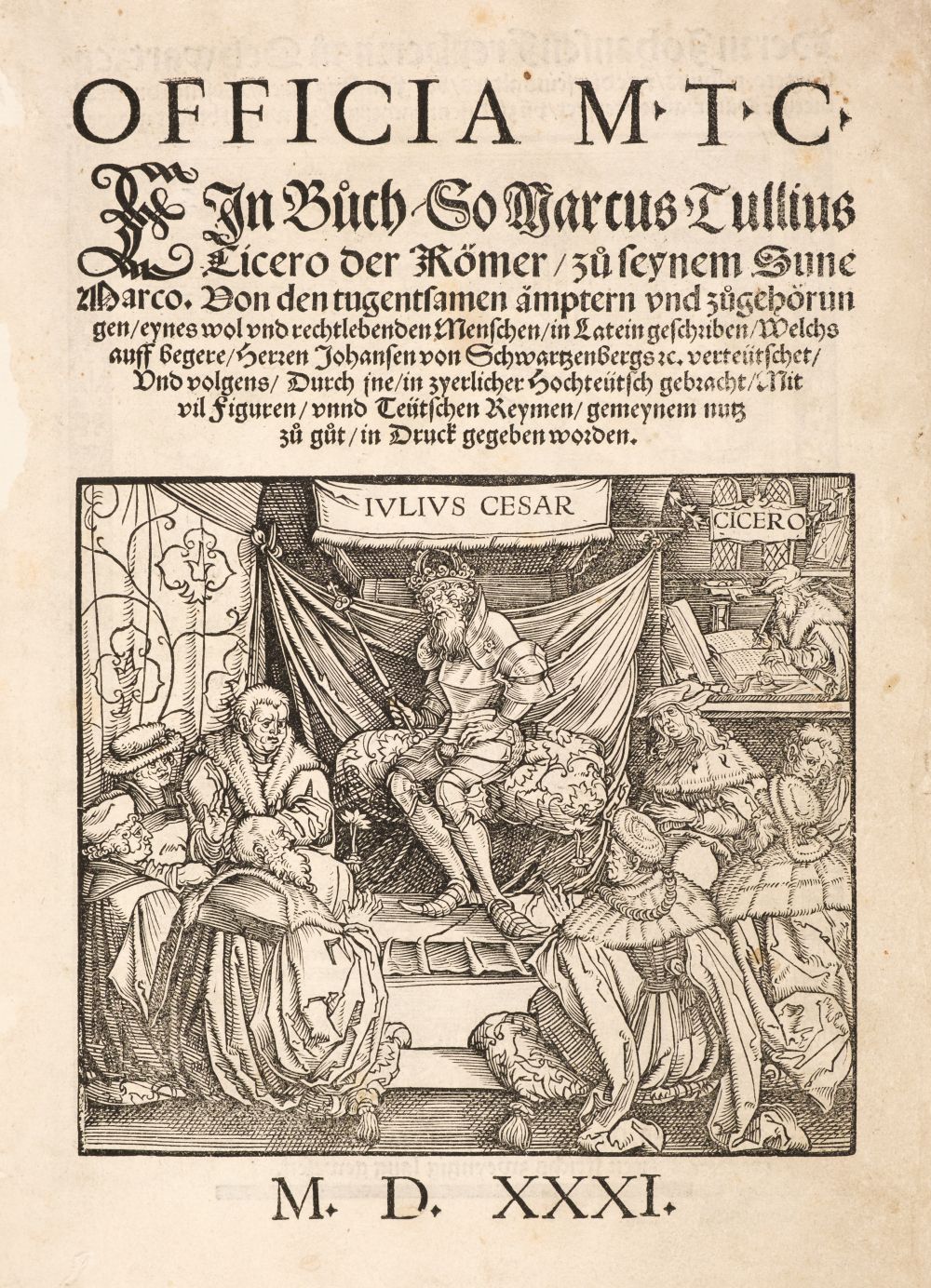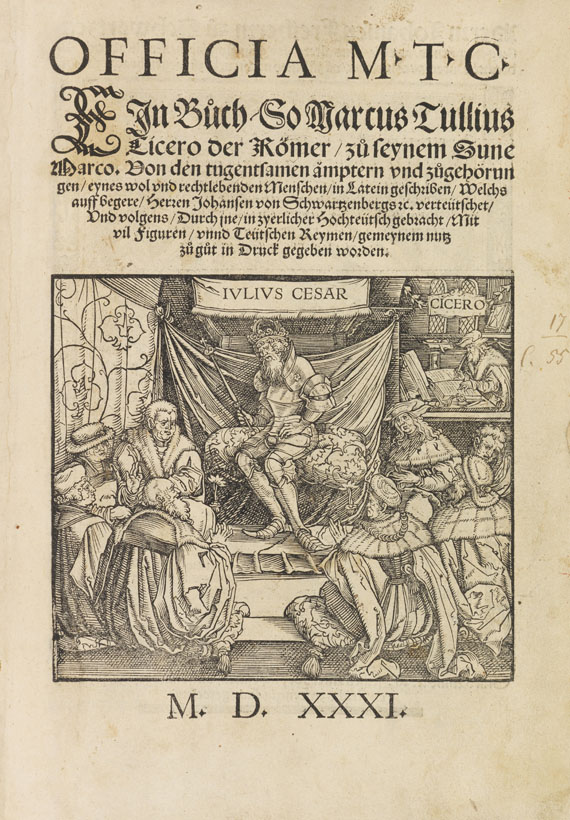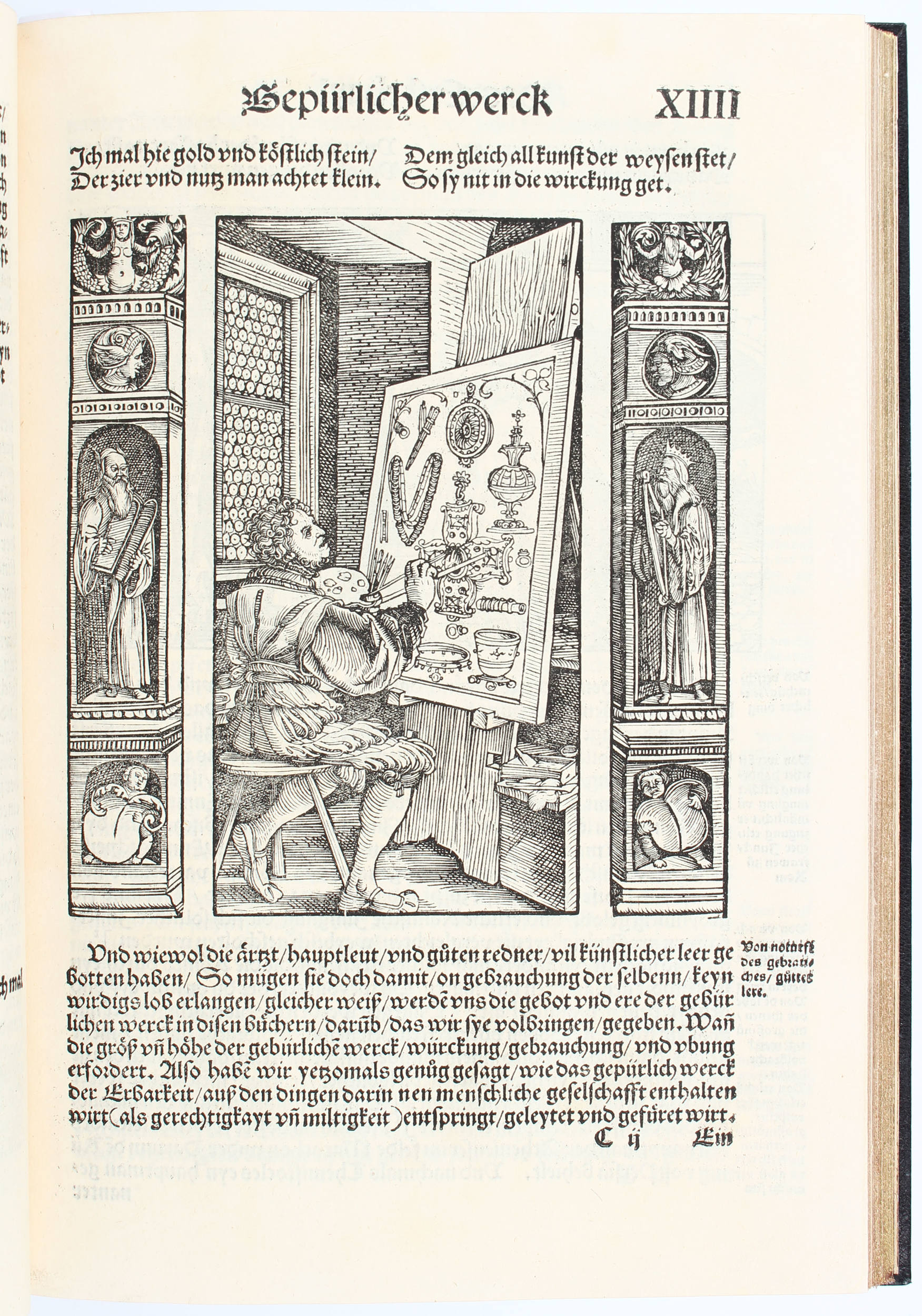Cicero, Marcus Tullius. Officia M. T. C. Ein Buch so Marcus Tullius Cicero der Römer zu seynem Sune Marco. Von den tugentsamen ämptern und zugehörungen, eynes wol und rechtlebenden Menschen, in Latein geschriben, Welchs auff begere, Herren Johansen von Schwartzenbergs &c. verteütschet. Und volgens Durch jne in zyerlicher Hochteütsch gebracht mit vil Figuren unnd Teütschen Reymen gemeynem nutz zu gut in Druck gegeben worden. (Augsburg: Heinrich Steiner, 29 April) 1531
A finely illustrated version of Cicero's book of duties, transformed by Johann von Schwarzenberg and Johann Neuber into a "Christian manual of virtue" (Enenkel, p.181), with illustrations mostly by Hans Weiditz This was first printed by Steiner on 16 February, then quickly reprinted and reissued in April, as here, and again in December.It has been opined that this translation, with its numerous woodcut illustrations, could actually be considered the first emblem book, predating by just twelve days the first printing of Alciati (lots 435-436), which was also produced by Steiner in Augsburg. The illustrations in this Cicero have a short motto above and a prose description below, very much in the style of Alciati's emblems, and Cicero's text was selected and adapted by Schwarzenberg to fit this pattern. Enenkel (p. 168) considers that Steiner, not Alciati, should be seen as the originator of the emblem book.
The woodcut illustrations, featuring characters in contemporary southern German attire and contemporary settings, were not all cut for this work. Some were previously used for German editions of Petrarch and some had been acquired by Steiner from the printer Sigmund Grimm. The new ones were cut to the designs of Schwarzenberg. The scenes depicted give a fascinating view of contemporary activities, featuring commerce and industry, hunting, fighting, banquets, medical scenes, painting, and music.The floral roll-tool on the border also appears on two bindings in Munich, and have been assigned to an Augsburg bindery (EBDB w004519).
Folio (294 x 196 mm). Gothic type, 43 lines plus headline. collation: [*]8 A-O6 P8: 99 leaves (of 100, without final blank). Woodcut illustration on title-page, woodcut portrait of the translator on the verso of the title-page (after Dürer), woodcut initials and tailpieces, numerous woodcut illustrations, some with letterpress captions, some signed H.W. for Hans Weiditz one signed H.B. for Hans Burgkmair (Occasional light soiling.)
binding: Contemporary calf over pasteboard (304 x 215 mm), probably made in Augsburg, roll-tooled floral outer border and central panel composed of three lines of a leaf and flower roll, all within blind-ruled panels, two pairs of later leather ties. (Binding repaired and rebacked retaining some of original spine, corners repaired, new pastedowns.)
acquisition: Purchased in 1996 from Jörg Schäfer, Zurich, catalogue 46 (1996), item 8. references: VD16 C 3239; Karl A.E. Enenkel, "Illustrations as commentary and readers' guidance: the transformation of Cicero's De Officiis into a German emblem book by Johann von Schwarzenberg, Heinrich Steiner, and Christian Egenolff (1517-1520; 1530-1531; 1550) in Transformations of the Classics via early modern commentaries (Leiden: Brill, 2013), p.160 onwards
Cicero, Marcus Tullius. Officia M. T. C. Ein Buch so Marcus Tullius Cicero der Römer zu seynem Sune Marco. Von den tugentsamen ämptern und zugehörungen, eynes wol und rechtlebenden Menschen, in Latein geschriben, Welchs auff begere, Herren Johansen von Schwartzenbergs &c. verteütschet. Und volgens Durch jne in zyerlicher Hochteütsch gebracht mit vil Figuren unnd Teütschen Reymen gemeynem nutz zu gut in Druck gegeben worden. (Augsburg: Heinrich Steiner, 29 April) 1531
A finely illustrated version of Cicero's book of duties, transformed by Johann von Schwarzenberg and Johann Neuber into a "Christian manual of virtue" (Enenkel, p.181), with illustrations mostly by Hans Weiditz This was first printed by Steiner on 16 February, then quickly reprinted and reissued in April, as here, and again in December.It has been opined that this translation, with its numerous woodcut illustrations, could actually be considered the first emblem book, predating by just twelve days the first printing of Alciati (lots 435-436), which was also produced by Steiner in Augsburg. The illustrations in this Cicero have a short motto above and a prose description below, very much in the style of Alciati's emblems, and Cicero's text was selected and adapted by Schwarzenberg to fit this pattern. Enenkel (p. 168) considers that Steiner, not Alciati, should be seen as the originator of the emblem book.
The woodcut illustrations, featuring characters in contemporary southern German attire and contemporary settings, were not all cut for this work. Some were previously used for German editions of Petrarch and some had been acquired by Steiner from the printer Sigmund Grimm. The new ones were cut to the designs of Schwarzenberg. The scenes depicted give a fascinating view of contemporary activities, featuring commerce and industry, hunting, fighting, banquets, medical scenes, painting, and music.The floral roll-tool on the border also appears on two bindings in Munich, and have been assigned to an Augsburg bindery (EBDB w004519).
Folio (294 x 196 mm). Gothic type, 43 lines plus headline. collation: [*]8 A-O6 P8: 99 leaves (of 100, without final blank). Woodcut illustration on title-page, woodcut portrait of the translator on the verso of the title-page (after Dürer), woodcut initials and tailpieces, numerous woodcut illustrations, some with letterpress captions, some signed H.W. for Hans Weiditz one signed H.B. for Hans Burgkmair (Occasional light soiling.)
binding: Contemporary calf over pasteboard (304 x 215 mm), probably made in Augsburg, roll-tooled floral outer border and central panel composed of three lines of a leaf and flower roll, all within blind-ruled panels, two pairs of later leather ties. (Binding repaired and rebacked retaining some of original spine, corners repaired, new pastedowns.)
acquisition: Purchased in 1996 from Jörg Schäfer, Zurich, catalogue 46 (1996), item 8. references: VD16 C 3239; Karl A.E. Enenkel, "Illustrations as commentary and readers' guidance: the transformation of Cicero's De Officiis into a German emblem book by Johann von Schwarzenberg, Heinrich Steiner, and Christian Egenolff (1517-1520; 1530-1531; 1550) in Transformations of the Classics via early modern commentaries (Leiden: Brill, 2013), p.160 onwards









.jpg)
.jpg)



Testen Sie LotSearch und seine Premium-Features 7 Tage - ohne Kosten!
Lassen Sie sich automatisch über neue Objekte in kommenden Auktionen benachrichtigen.
Suchauftrag anlegen